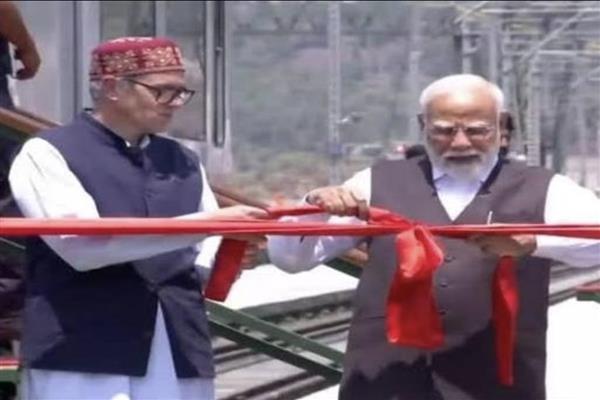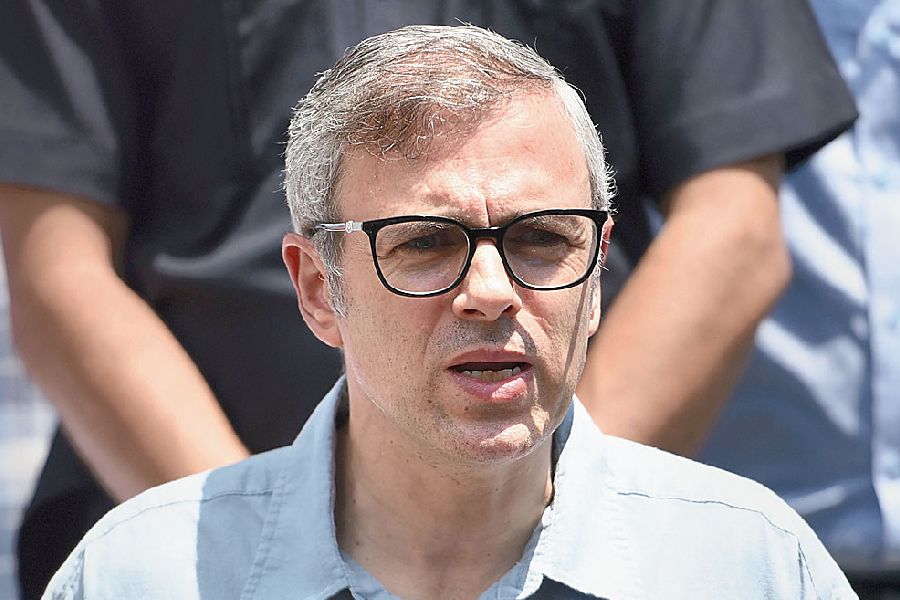‘L-G Got Promoted, I Got Demoted’: Omar Abdullah Rekindles Statehood Debate in PM Modi’s Presence at Chenab Bridge Inauguration
Jammu & Kashmir 06 June 2025: In a politically charged and emotionally resonant moment, former Jammu and Kashmir Chief Minister Omar Abdullah shared the stage with Prime Minister Narendra Modi and Lieutenant Governor Manoj Sinha, raising a sharp yet humorous point on the region’s downgraded status. The occasion was the grand inauguration of multiple infrastructure projects, most notably the Chenab Rail Bridge—the world’s highest railway arch bridge—and the Katra-Srinagar Vande Bharat Express. While the event was primarily focused on showcasing development milestones, Abdullah’s comments reignited the long-standing debate on restoring statehood to Jammu and Kashmir.
The Political Flashpoint: Omar Abdullah’s Statement on Stage
During the high-profile event, Omar Abdullah did not shy away from voicing his concerns. Reflecting on the political changes post-2019, Abdullah humorously noted:
“The same four people were present here in 2014 when the Katra Railway Station was inaugurated. While the then MoS Railways, Manoj Sinha, got promoted to the post of J&K LG, I got demoted from CM of a state to CM of a UT.”
The audience responded with murmurs and mild applause as Abdullah’s quip underlined a deeper political sentiment—that the people of Jammu and Kashmir feel left behind in India’s federal structure. His words were a strategic, polite nudge directed at Prime Minister Modi, subtly urging the restoration of full statehood to the Union Territory.
Despite the light tone, the message was clear: Omar Abdullah positioned himself as a voice for democratic representation and local empowerment in the region.
Background: The Statehood Controversy Post-Article 370 Abrogation
What Changed in 2019?
On August 5, 2019, the Government of India revoked Article 370 and Article 35A, special constitutional provisions that granted Jammu and Kashmir autonomy in internal matters. This was followed by the Jammu and Kashmir Reorganisation Act, which bifurcated the state into two union territories: Jammu & Kashmir (with a legislative assembly) and Ladakh (without one).
This move ended the state’s autonomous status and dissolved its elected government. Political leaders like Omar Abdullah and Mehbooba Mufti were detained, and a Lieutenant Governor was appointed to administer the UT.
The Aftermath
Supporters of the decision hailed it as a bold move to integrate J&K into the Indian mainstream and encourage investment and development. Critics, however, saw it as a violation of constitutional guarantees and a setback for democratic governance in the region.
Four years later, calls for the restoration of statehood continue to surface—especially during high-profile events such as this one.
Omar Abdullah’s Political Legacy and Strategic Timing
Omar Abdullah, son of veteran leader Farooq Abdullah, has served as the Chief Minister of J&K from 2009 to 2015. He remains one of the most influential voices from the National Conference party.
Abdullah’s speech at the Chenab Bridge inauguration was more than a nostalgic reflection. It was a calculated moment to:
- Re-establish his role in J&K’s political landscape
- Advocate for restoration of democratic processes
- Highlight the emotional and administrative costs of the region’s demotion
While he expressed optimism that PM Modi would fulfill his earlier promises of restoring statehood, the speech tactfully put the central government on notice before the upcoming general and state elections.
PM Modi’s Development Agenda: A Showcase of Infrastructure Excellence
While Omar Abdullah’s remarks grabbed political headlines, the core agenda of the event was monumental: the formal inauguration of the Chenab Rail Bridge and several key railway projects, including the Katra-Srinagar Vande Bharat Express.
Chenab Bridge – An Engineering Marvel
Dubbed the “Eiffel Tower of India,” the Chenab Rail Bridge is more than a structural achievement; it is a symbol of India’s commitment to connecting its most remote regions.
🔍 Key Specifications:
- Height: 359 meters (1,178 feet) above the Chenab River
- Length: 1,315 meters
- Main Arch Span: 467 meters
- Materials Used: Over 28,000 metric tonnes of steel
- Designed to Withstand:
- Wind speeds up to 260 km/h
- Seismic activity (Zone V standards)
- Extreme temperature variations from -20°C to +45°C
This single bridge has connected the Kashmir Valley with the rest of India’s railway network, reducing travel time, improving logistics, and bolstering defense mobility.
Economic & Strategic Importance of the Chenab Bridge
1. Connectivity Boost
The bridge is part of the Udhampur-Srinagar-Baramulla Railway Line (USBRL), a long-term project aimed at integrating the Kashmir Valley with India’s national transportation grid.
- Reduces travel time from Jammu to Baramulla
- Eases movement for pilgrims to Vaishno Devi and Amarnath
- Facilitates trade and tourism by improving accessibility
2. Strategic Value
Given the proximity to international borders, this bridge allows for faster deployment of troops and materials in times of conflict.
3. Tourism Growth
Kashmir’s economy depends heavily on tourism. With seamless rail access:
- Domestic tourist inflow is expected to increase by over 40%
- Remote destinations like Sonmarg, Pahalgam, and Gulmarg will become more accessible
Operation Sindoor and the PM’s First Visit Since the Pahalgam Attack
PM Modi’s visit to J&K holds special significance as it comes just weeks after Operation Sindoor, a retaliatory strike carried out by Indian forces after the April 22 terrorist attack in Pahalgam, which killed 26 civilians and security personnel.
By visiting the region soon after a major counter-terror operation, Modi sent a strong political and military signal:
- Development and security go hand-in-hand
- Terrorism will not deter India’s infrastructure push in Kashmir
- The Centre is committed to rebuilding trust through governance and growth
The Broader Political Context: Statehood, Elections & Public Sentiment
1. Public Demand for Statehood
The people of J&K have consistently voiced their demand for restoration of statehood and early elections. While delimitation of assembly constituencies has been completed, no timeline has been announced for polls.
2. Centre’s Stand
The Modi government has maintained that statehood will be restored “at an appropriate time” after ensuring peace and stability. However, with repeated delays, skepticism among the public is growing.
3. Electoral Strategy
Omar Abdullah’s remarks could be seen as a strategic move to consolidate his support base and corner the BJP in the region. It also allows the National Conference to differentiate itself from parties seen as aligned with the Centre.
Pakistan’s Reaction & Geopolitical Ripples
Omar Abdullah’s statement and Modi’s J&K visit come at a time when Pakistan has escalated rhetoric on Kashmir:
- Islamabad has declared the Simla Agreement “dead”, reopening its Kashmir policy
- Cross-border tensions remain high with increased infiltration attempts
Meanwhile, the massive deployment of 581 companies of Central Armed Police Forces (CAPFs) for the Amarnath Yatra highlights the government’s concerns about internal security and foreign-sponsored threats.
Looking Ahead: Can Development Bridge the Political Divide?
As the Chenab Bridge physically connects Kashmir with the rest of India, the political divide remains wide. Omar Abdullah’s statements reflect a local yearning for political agency, while PM Modi’s focus remains on infrastructure and security.
Both elements—governance and grassroots democracy—are essential for long-term peace and integration in Jammu and Kashmir.
Will the Chenab Bridge become a metaphor for unity, or will it stand as a stark contrast to unfulfilled political aspirations? That remains to be seen.
Bottom-Line: Beyond Steel and Speeches
The inauguration of the Chenab Rail Bridge and the return of the statehood debate make one thing clear: Jammu and Kashmir stands at a crossroads.
Omar Abdullah’s subtle criticism and PM Modi’s infrastructural push offer two visions for the region. As the world’s highest rail bridge captures global attention, it’s also drawing focus to the emotional and constitutional journey of the people of J&K.


